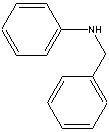PRODUCT IDENTIFICATION

CLASSIFICATION
PHYSICAL AND CHEMICAL PROPERTIES
152 C
APPLICATIONS
APPEARANCE
MELTING POINT
34 C min
|
|
|
| N-PHENYLBENZYLAMINE | ||
|
PRODUCT IDENTIFICATION |
||
| CAS NO. | 103-32-2 |
|
| EINECS NO. | 203-100-4 | |
| FORMULA | C6H5CH2NHC6H5 | |
| MOL WT. | 183.25 | |
| H.S. CODE | 2921.42 | |
| TOXICITY | ||
| SYNONYMS | N-phenyl-Benzenemethanamine; | |
| N-Benzylaniline; Benzylaniline; | ||
| RAW MATERIALS |
|
|
|
CLASSIFICATION |
|
|
|
PHYSICAL AND CHEMICAL PROPERTIES |
||
| PHYSICAL STATE | colorless to pale yellow crystalline powde | |
| MELTING POINT | 35 C | |
| BOILING POINT | 306 C | |
| SPECIFIC GRAVITY | 1.069 | |
| SOLUBILITY IN WATER | ||
| AUTOIGNITION |
| |
| pH | ||
| VAPOR DENSITY | ||
| REFRACTIVE INDEX | ||
| NFPA RATINGS | Health: 1; Flammability: 1; Reactivity: 0 | |
| FLASH POINT |
152 C | |
| STABILITY | Stable under ordinary conditions | |
|
APPLICATIONS |
||
| One of the most important aromatic amines is aniline; pale brown liquid boiling at 184 C, melting at -6 C. Aniline is obtained commercially from chlorobenzene by heating with ammonia in the presence of copper catalyst or from a product of coal tar (nitrobenzene) through the reduction reaction. Aniline is the starting material in the dye manufacturing industry and as in the manufacture of others. Aniline is converted into sulfanilic acid which is the parent compound of the sulfa drugs. Aniline and its derivatives are also important in the manufacture of rubber-processing chemicals, antioxidants and varnishes. | ||
| SALES SPECIFICATION | ||
|
APPEARANCE |
colorless to pale yellow crystalline powder | |
| ASSAY (GC) | 99.0% min | |
|
MELTING POINT |
34 C min | |
| TRANSPORTATION | ||
| PACKING | 200kgs in Drum | |
| HAZARD CLASS | ||
| UN NO. | ||
| REMARKS | ||
| Antioxidant is a substance added in small quantities to hydrocarbons which are susceptible to oxidation, such as rubbers, plastics, foods, and oils to inhibit or slow oxidative processes, while being itself oxidized. Antioxidants work in two different ways. In primary antioxidants (also called free-radical scavengers), antioxidative activity is implemented by the donation of an electron or hydrogen atom to a radical derivative. These antioxidants are usually hindered amines (p-Phenylene diamine, trimethyl dihydroquinolines, alkylated diphenyl amines) or substituted phenolic compounds with one or more bulky functional groups such as a tertiary butyl at 2,6 position commonly. Butylated hydroxytoluene (BHT) is a common example of hindered phenolic antioxidant. The reaction rate, or carbocation stability, in SN1 mechanism is 3° > 2° > 1° > CH3 (no SN1) so, tertiary alkyl moiety exists in lots of phenolic antioxidant compounds. Primary antioxidants are free radical scavengers which combine with peroxy radicals and break autocatalytic cycle. In secondary antioxidants ( also called peroxide decomposers), activity is implemented by the removal of an oxidative catalyst and the consequent prevention of the initiation of oxidation. Examples of peroxide decomposer type of antioxidant are trivalent phosphorous and divalent sulfurcontaining compound such as sulfides, thiodipropionates and organophosphites. Synergistic effect is expected when primary antioxidants are used together with secondary antioxidants as primary antioxidants are not very effective against the degradation by UV oxidation. Sometimes, chelating agents are added to scavenge metal impurities which can initiate decomposition. | ||
|
|
|